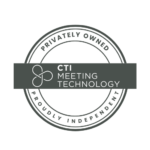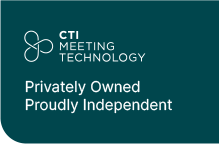Presentation Management software is crucial to efficiently organize all the content in your scientific conference. Imagine going into a library and having thousands of books stacked with no order. Finding the right genre and book must be frustrating! This is the same feeling admins get when they manually collect and organize hundreds of files for the meeting. In the same way, users trying to find sessions and presentations face a considerable challenge when there’s no organization system.
The good news is that event technology is here to help! Presentation Management software streamlines event content management for admins and offers easy search capabilities for users. No need to spend hours manually organizing and hunting down presentations anymore.
But with so many options in the market, how do you decide which one is suitable for your organization? Keep reading for 10 essential features that presentation management software must include for a successful meeting planning experience.
1. Centralized Content Management
One of the main advantages of online content organization software is the possibility to store limitless files in the same place. Not only is it easier for organizers to track and view all submissions, but submitters can also access the content from any location as long as they have internet connectivity. This flexibility is invaluable when managing hundreds of presentation files, ensuring that the latest version always trumps older ones. Presentation Management software offers a centralized hub where all your files live, accessible from any device with an internet connection. This is a game changer for organizers and presenters alike, allowing real-time access to the latest versions of presentations. No more last-minute panic; presenters can adjust their content any time before their session begins, ensuring the most current content is presented. Additionally, consider the following:
- Allow different file types and guide submitters through the process to ensure presentations are ready at the session.
- Integrate with other modules such as Abstract Management software and ePoster Management software to streamline the event content managing process.
- Make sure the tool is scalable to support even large conferences with thousands of files.
- Keep access to the submitting platform secure and only available to submitters and other authorized users.
2. Media & File Control
Media controls guide presenters to upload appropriate file types (e.g., PDF and MP4), with online editing capabilities supported by Speaker Ready Room computers. These are the computers used at the venue onsite by submitters to view and make last-minute changes to their presentations. This collaboration allows presentations to flow smoothly while the Presentation Management Agent ensures that presentations are available in the correct session rooms at the right times, making it a breeze for presenters.
3. Brand Consistency Tools
Event branding is essential, making it easily identifiable. Just as you can spot a Starbucks or McDonalds at first glance, your presentations should also have a recognizable style. Clear guidelines and templates should be established for all submitters, ensuring a cohesive feel and simplifying their tasks.
Customization options let you personalize colors, fonts, and logos, transforming a generic site into an identifiable page for your event. You also want to design presentation templates that align with this identity. Finally, adding logical search categories and filters makes finding relevant content easier.
Read our event branding tips if you want to know more.
4. User-Friendly Search & Content Organization
Tagging each presentation is critical to help users swiftly find the right content. Advanced search and filtering options enable attendees to find their desired presentations based on specific criteria. Don’t make your users scroll through endless pages! A user-friendly interface, with well-labeled sections and a reliable search feature, can dramatically enhance the user experience.
It might also be helpful to provide navigation and search instructions so users can access all the meeting content without frustration.
5. Security & Privacy Measures
As an organizer, you manage personal details from so many people and need to ensure all this data remains safe and only available to authorized users. User access controls, data encryption, and compliance with industry standards prioritize data security.
One of the ways to enforce security is to restrict presentations to the intended audience, which can be achieved with registration codes. Customizable access controls and permissions ensure that presentations are shared securely and only with authorized users. User access controls, data encryption, and compliance with industry standards prioritize data security.
6. Detailed Analytics & Reporting
A great presentation management system should offer analytics and engagement tracking capabilities. This allows presenters and administrators to track views and engagement metrics for presentations. These insights help evaluate presentation performance, identify popular content, and make data-driven decisions to improve future presentations and meetings.
Here are some of the statistics you should be looking at:
- Engagement Metrics: Understand how engaged your audience is with the content by tracking metrics such as time spent on each slide, interaction levels (such as clicking on links or documents), and audience questions or comments submitted during the presentation.
- Content Performance: Discover the most popular presentations by analyzing metrics like the number of views, downloads, and shares. This data can enable you to tailor future meeting content to align with audience preferences and interests.
- Audience Feedback: You can collect feedback from attendees through surveys or polls integrated into the presentation software. Analyze responses to understand audience satisfaction levels, identify areas for improvement, and gather insights for enhancing the overall event experience.
- Audience Demographics: Organizers can also gain insights into your audience demographics, including geographical location, job roles, industries, or interests. Understanding your audience can help you tailor content and communication strategies to better resonate with specific segments and enhance engagement.
- Performance Benchmarks: Compare performance metrics across different presentations, speakers, or events to identify trends, best practices, and areas for improvement.
7. Integration With Third-Parties
To make the process smoother, having presentation management software integrated with other modules like Abstract or ePoster Management allows you to manage all meeting content from the same admin interface.
Seamless integration with other modules optimizes meeting content organization and communication efficiency, allowing you to create a unified and seamless experience for your attendees and team.
See how CTI’s Presentation Management software integrates with other meeting modules.
8. Mobile Responsive
Your attendees are busy people. Many attendees will miss a few sessions and want to catch up later. For maximum flexibility, make sure that the meeting content is accessible through multiple different devices. Users can interact with meeting content from smartphones or tablets, ensuring maximum convenience and a seamless experience, regardless of location or device.
No matter which device your participants use to access the content, they can seamlessly interact with the meeting materials, fostering greater engagement and participation throughout the event.
9. Customization & Flexibility Features
Your organization is unique, and your presentation management software should support that. The platform offers customizable user interfaces, adaptable workflows, and API availability to foster adaptability and integration with your existing systems. These customizable features empower you to tailor the software to fit your needs, creating a seamless and efficient workflow that aligns with your organization’s processes.
Furthermore, AI-powered transformations enhance content curation and distribution, providing a seamless user experience while leveraging the power of artificial intelligence to take your event to the next level. With these flexible and adaptable capabilities, you can ensure that the software seamlessly integrates with your organization’s unique requirements and workflows.
10. Training Options & Support
You want to work with a provider that stays ahead and adapts to industry changes. However, that implies that organizers need to train with the software. Tutorials help you learn all the features and how to use them to your advantage.
Moreover, having a technical support team is crucial to answer any questions you might have about the software and provide further training if needed. Choose a provider that offers several flexible training options, whether short-form video tutorials, live training sessions, or one-on-one training.
Wrapping Up…
In conclusion, presentation management is the cornerstone of organizing a successful scientific conference whether in-person or hybrid. From efficient content storage and collaborative editing to robust security measures and advanced analytics, these features pave the way for seamless event management. By leveraging these tools, event organizers can easily navigate the complexities of conference planning, ensuring a successful and engaging experience for all stakeholders.
Looking for the right software for your next meeting? Explore our event management solutions or schedule a call to discuss your needs.





